
Welcome to CivilGEO Knowledge Base
Welcome to CivilGEO Knowledge Base

Welcome to CivilGEO Knowledge Base
Welcome to CivilGEO Knowledge Base
The Assign Multiple Cross Sections command enables the user to select a group of existing polylines on the Map View as cross sections and prompt the software to extract the HEC-RAS cross section geometry from the underlying ground terrain.
Follow the steps below to use the Assign Multiple Cross Sections command:
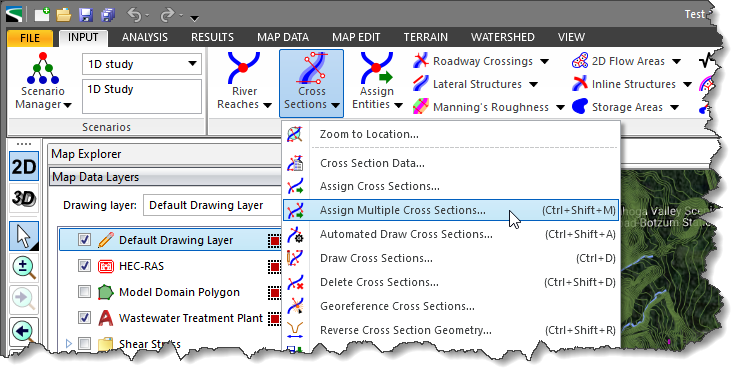
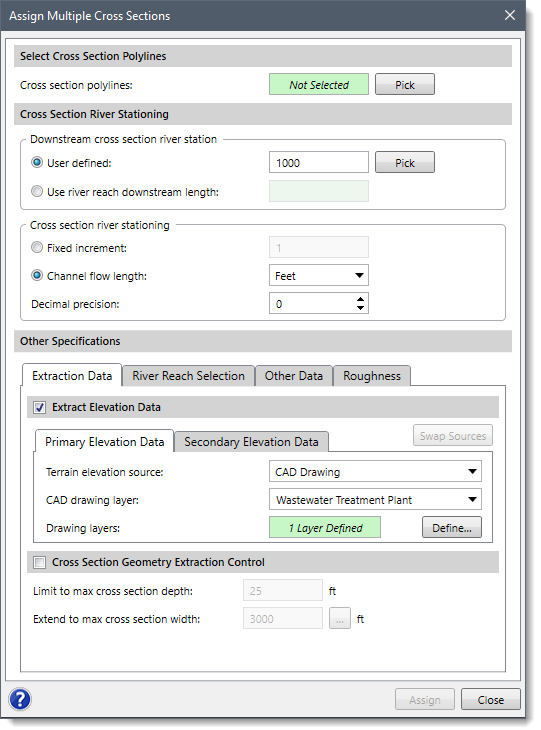
The following sections describe the Assign Multiple Cross Sections command and how to interact with the above dialog box.
The Select Cross Section Polylines section is used to interactively select polylines from the Map View for assigning as HEC-RAS cross sections. Click the [Pick] button and the dialog box will temporarily disappear. A prompt will be displayed on the status bar, informing the user what to do next. Within the Map View, click on the polylines to assign as cross sections.
![[Pick] button](/wp-content/uploads/sites/25/2014/12/Assign-Multiple-Cross-Sections-Img-3.png)
To select all the polylines on the same map data layer, first select one polyline on the Map View. Then right-click and choose Select Similar from the displayed context menu. The software will then select all the polylines contained on that layer.
When finished selecting the polylines, right-click and choose Done from the displayed context menu or press the Enter key. The Assign Multiple Cross Sections dialog box will be redisplayed, and the number of selected polylines will be shown in the Cross section polylines entry.

Note that cross sections cannot already exist for the corresponding river reach. If cross sections already exist, then use the Assign Cross Sections command instead. Refer to this article to learn more about this command.
This section is used to define the river stationing of the selected cross sections. After selecting the cross section polylines, the software will automatically compute the river station of the cross sections based upon the parameters defined in this section.
For the cross sections being constructed, the river stationing value after the decimal point can be defined using the Decimal precision spin control. Cross sections can be numbered using a fixed increment or by the river chainage along the river reach. The river chainage can be in miles or feet when working in US units, or kilometers or meters when working in metric (SI) units.
This tabbed panel is used to define the data extraction specifications for the assigned cross sections.
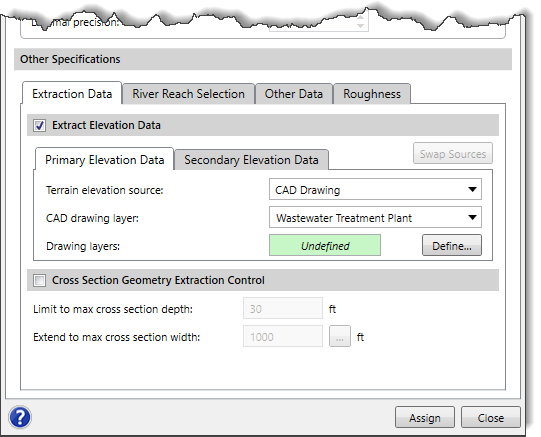
This optional section is used to define the elevation data source(s) to be used for extracting the cross section geometry. The user can use the Primary and Secondary Elevation Data panels to define the primary and secondary (if available in the project) elevation data sources for extracting the weir crest geometry. Depending upon the elevation data source type that is selected, different options are provided to specify additional elevation data information.
Refer to this article in our knowledge base for information on the types of terrain elevation data that can be used for constructing cross sections.
When a secondary elevation data source is available, the software will form a concave hull around the primary elevation data source to identify its bounds. For locations where elevation data from the primary data source is unavailable, the software will use the elevation data from the secondary data source.
Note that the user cannot utilize the same data source for defining the primary and secondary elevation data.
The user can click the [Swap Sources] button to swap the selected elevation source from primary elevation data to secondary elevation data and vice versa.
If the section checkbox is unchecked, then the subsequent sections below it will be unavailable (i.e., grayed out). In addition, no geometry will be created when the cross section is created. The cross section will just be a flat horizontal line at elevation 0.
This optional section is used to control the amount of the cross section geometry to extract for the selected polyline. This assures that an adequately deep cross section is created on both sides of the river reach. The software will attempt to retrieve the cross section geometry data to the depth specified within the maximum cross section width specified.
If the selected polyline does not extend outward far enough to reach the cross section depth specified, the software will automatically extend the constructed cross section further outward. Similarly, if the selected polyline extends too far outward for the depth specified, the software will automatically trim the constructed cross section.
This tabbed panel allows the user to define whether the Assign Multiple Cross Sections command should be applied to all river reaches contained within a project, or a specific river reach.
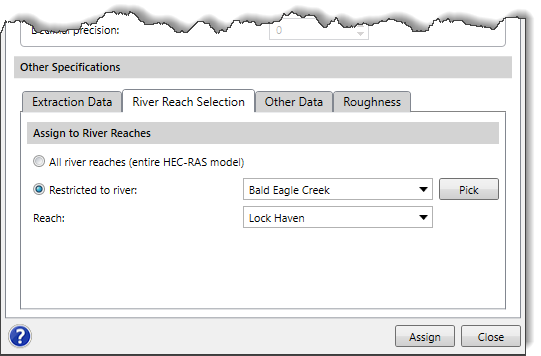
The following options are provided:
This tabbed panel is used to define channel bank locations based upon the options selected for the constructed cross sections.
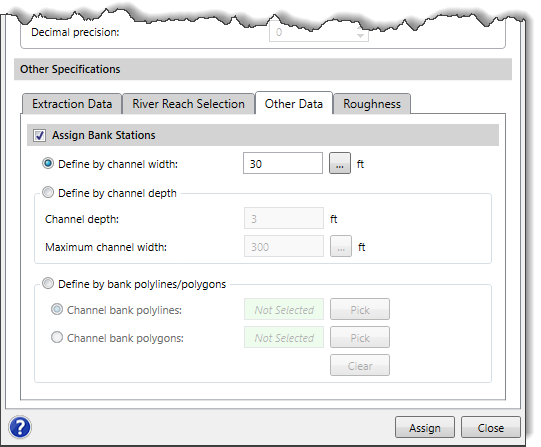
This optional section is used to construct HEC‑RAS channel bank locations based upon the selected option. The following options are available:
This option will assign the bank stations using a defined channel width. The software will first determine where the thalweg location is on the cross section. It will then move outward from the thalweg equally until the requested channel width is reached.
This option will assign the bank stations using an assumed normal flow depth and a maximum channel width search distance. The software will first determine where the thalweg location is on the cross section. It will then move outward from the thalweg until the requested channel depth is reached within the maximum channel width specified.
This option will assign the bank stations using selected polylines or polygons. Using the corresponding [Pick] buttons, the user can interactively select individual polylines or polygons on the Map View to be associated as bank stations. The user can click the [Clear] button to cancel the previous selection and redo the entire process.
The software will first determine where the thalweg location is on the cross section. It will then move outward from the thalweg until a previously selected bank polyline or polygon edge is reached.
During the construction of the cross sections, the software will automatically assign a default Manning’s roughness for the left overbank, channel, and right overbank areas. The user can adjust these Manning’s roughness values in the Roughness tabbed panel.
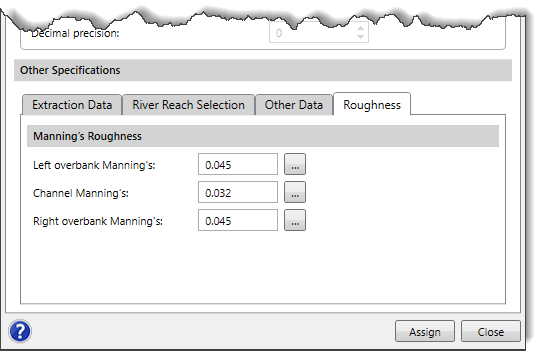
In addition, the flow length to the next downstream cross section is determined. If inserting a new cross section between two adjacent cross sections, the software will automatically adjust the flow length of the next upstream cross section to account for the insertion of the new cross section.
 1-800-301-02-955
1-800-301-02-955
 608-729-5100
608-729-5100
(US and Canada)
 [email protected]
[email protected]
 +1 608-729-5100
+1 608-729-5100
CivilGEO India
Graphix Tower, A-13 A
3rd Floor, Sector 62
Noida, Uttar Pradesh 201309
IndiaTel:
1-800-301-02-955 or
+91 022-3831-8601
CivilGEO United States
8383 Greenway Blvd
6th Floor
Middleton, WI 53562
USATel:
608-729-5100 or
800-488-4110
Copyright © CivilGEO, Inc. All rights reserved. The CivilGEO logo, “GeoSTORM”, “GeoHECHMS”, “GeoHECRAS”, and “Ready To Engineer” are registered trademarks of CivilGEO,Inc.
All other brands, company names, product names or trademarks belong to their respective holders.
We use cookies to give you the best online experience. By agreeing you accept the use of cookies in accordance with our cookie policy.
When you visit any web site, it may store or retrieve information on your browser, mostly in the form of cookies. Control your personal Cookie Services here.
The ZoomInfo WebSights snippet drops three cookies to track Unique Visits:
1. _pxhd - Related to the Perimeter X security layer (Perimeter X isused to prevent bot attacks).
2. _cfduid - Related to the CloudFlare security layer (CloudFlare is the Network Security protocol that ZoomInfo uses to orchestrate the rate limiting rules).
3. visitorId - This is how WebSights identifies recurring visitors








